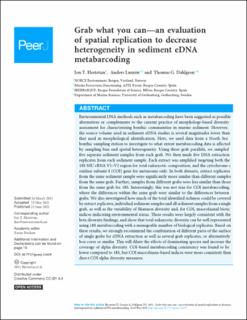| dc.description.abstract | Environmental DNA methods such as metabarcoding have been suggested as possible alternatives or complements to the current practice of morphology-based diversity assessment for characterizing benthic communities in marine sediment. However, the source volume used in sediment eDNA studies is several magnitudes lower than that used in morphological identification. Here, we used data from a North Sea benthic sampling station to investigate to what extent metabarcoding data is affected by sampling bias and spatial heterogeneity. Using three grab parallels, we sampled five separate sediment samples from each grab. We then made five DNA extraction replicates from each sediment sample. Each extract was amplified targeting both the 18S SSU rRNA V1–V2 region for total eukaryotic composition, and the cytochrome c oxidase subunit I (COI) gene for metazoans only. In both datasets, extract replicates from the same sediment sample were significantly more similar than different samples from the same grab. Further, samples from different grabs were less similar than those from the same grab for 18S. Interestingly, this was not true for COI metabarcoding, where the differences within the same grab were similar to the differences between grabs. We also investigated how much of the total identified richness could be covered by extract replicates, individual sediment samples and all sediment samples from a single grab, as well as the variability of Shannon diversity and, for COI, macrofaunal biotic indices indicating environmental status. These results were largely consistent with the beta diversity findings, and show that total eukaryotic diversity can be well represented using 18S metabarcoding with a manageable number of biological replicates. Based on these results, we strongly recommend the combination of different parts of the surface of single grabs for eDNA extraction as well as several grab replicates, or alternatively box cores or similar. This will dilute the effects of dominating species and increase the coverage of alpha diversity. COI-based metabarcoding consistency was found to be lower compared to 18S, but COI macrofauna-based indices were more consistent than direct COI alpha diversity measures. | |

